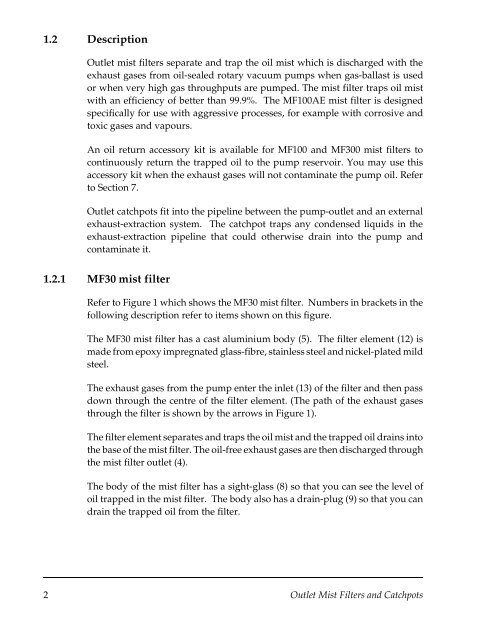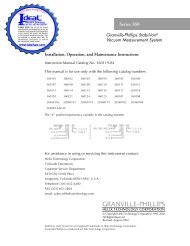Edwards, Outlet Mist Filters, Catchpots, MF30, MF100, MF100AE ...
Edwards, Outlet Mist Filters, Catchpots, MF30, MF100, MF100AE ...
Edwards, Outlet Mist Filters, Catchpots, MF30, MF100, MF100AE ...
You also want an ePaper? Increase the reach of your titles
YUMPU automatically turns print PDFs into web optimized ePapers that Google loves.
1.2 Description<br />
<strong>Outlet</strong> mist filters separate and trap the oil mist which is discharged with the<br />
exhaust gases from oil-sealed rotary vacuum pumps when gas-ballast is used<br />
or when very high gas throughputs are pumped. The mist filter traps oil mist<br />
with an efficiency of better than 99.9%. The <strong>MF100</strong>AE mist filter is designed<br />
specifically for use with aggressive processes, for example with corrosive and<br />
toxic gases and vapours.<br />
An oil return accessory kit is available for <strong>MF100</strong> and <strong>MF30</strong>0 mist filters to<br />
continuously return the trapped oil to the pump reservoir. You may use this<br />
accessory kit when the exhaust gases will not contaminate the pump oil. Refer<br />
to Section 7.<br />
<strong>Outlet</strong> catchpots fit into the pipeline between the pump-outlet and an external<br />
exhaust-extraction system. The catchpot traps any condensed liquids in the<br />
exhaust-extraction pipeline that could otherwise drain into the pump and<br />
contaminate it.<br />
1.2.1 <strong>MF30</strong> mist filter<br />
Refer to Figure 1 which shows the <strong>MF30</strong> mist filter. Numbers in brackets in the<br />
following description refer to items shown on this figure.<br />
The <strong>MF30</strong> mist filter has a cast aluminium body (5). The filter element (12) is<br />
made from epoxy impregnated glass-fibre, stainless steel and nickel-plated mild<br />
steel.<br />
The exhaust gases from the pump enter the inlet (13) of the filter and then pass<br />
down through the centre of the filter element. (The path of the exhaust gases<br />
through the filter is shown by the arrows in Figure 1).<br />
The filter element separates and traps the oil mist and the trapped oil drains into<br />
the base of the mist filter. The oil-free exhaust gases are then discharged through<br />
the mist filter outlet (4).<br />
The body of the mist filter has a sight-glass (8) so that you can see the level of<br />
oil trapped in the mist filter. The body also has a drain-plug (9) so that you can<br />
drain the trapped oil from the filter.<br />
2 <strong>Outlet</strong> <strong>Mist</strong> <strong>Filters</strong> and <strong>Catchpots</strong>
















